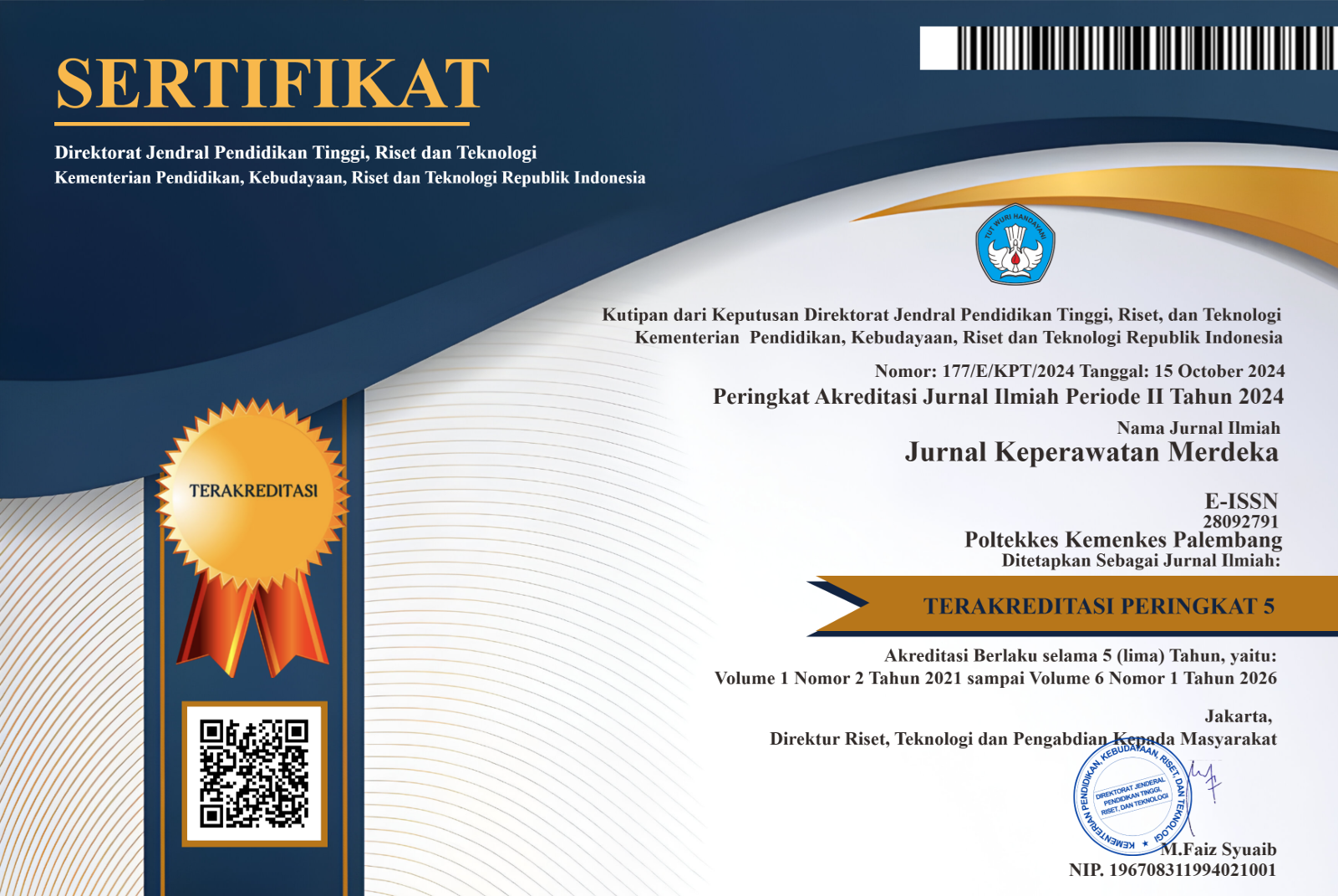Implementasi Keperawatan Latihan Rom Pasif Pada Pasien Stroke Non Hemoragik Dengan Gangguan Mobilitas Fisik
Abstract
Background: Non-hemorrhagic stroke occurs due to a blockage in the lumen of the blood vessels of the brain and has the highest prevalence in Indonesia. The problem that arises is decreased muscle strength. Passive ROM implementation can reduce physical mobility disorders. Method: Descriptive method in the form of a case study. Nursing Care Approach consisting of assessment, nursing diagnosis, planning, implementation, evaluation and nursing documentation. There were 2 subjects in this study, namely men and women with the same criteria, namely non-hemorrhagic stroke patients. This research was conducted at the Siti Fatimah Hospital in South Sumatra Province. Results: The results of mobilization support with non-pharmacological techniques in the form of Passive ROM exercises to increase muscle strength in non-hemorrhagic stroke patients were carried out for 3 consecutive days, range of motion increased and muscle weakness decreased. Patient 1, the muscle strength of the upper and lower extremities on the left previously scored 1 increased to a score of 2. Patient 2, the muscle strength of the upper and lower extremities on the right previously had a score of 2 to a score of 3. Conclusion: After Passive Range Of Motion is effective in the healing process of non-hemorrhagic stroke patients with impaired physical mobility, patient 1 and patient 2 increase muscle strength.
References
Anita, F., Pongantug, H., Ada, P. V., & Hingkam, V. (2018). Pengaruh Latihan Range of Motion terhadap Rentang Gerak Sendi Ekstremitas Atas pada PasiePasca Stroke di Makassar. Journal of Islamic Nursing, 3(1), 97–99.
Muchlis, A. E., Hendrawan, A. Z., Isni, N., & Sukandar, M. (n.d.). Keseimbangan Insan Pascastroke. 2(2), 32–39.
Mutiarasari, D., Kesehatan, B. I., Komunitas, M.-K., & Kedokteran, F. (2019). ISCHEMIC STROKE: SYMPTOMS, RISK FACTORS, AND PREVENTION. In Jurnal Ilmiah Kedokteran (Vol. 6, Issue 1).
Nurtanti, S., & Ningrum, W. (2018). Efektiffitas Range Of Motion (ROM) Aktif Terhadap Peningkatan Kekuatan Otot Pada Penderita Stroke. Jurnal Keperawatan GSH, 7(1), 14–18.
Qurbany, Z. T., & Wibowo, A. (2016). Stroke Hemoragik e.c Hipertensi Grade II. Jurnal Medula, 5(2), 114–118. http://juke.kedokteran.unila.ac.id/index.php/medula/article/view/1520
Selvia, D. (2015). Batasan Karakteristik Dan Faktor Yang Berhubungan (Etiologi) Diagnosa Keperawatan: Hambatan Mobilitas Fisik Pada Pasien Stroke. Universitas Lambung Mangkurat, 3(1), 12–21.
Vellyana Diny Asri & Rahmawati. (2021). Dukungan Keluarga pada Pelaksanaan Mobilisasi Dini Pasien Pasca Stroke Iskemik. Jurnal Kesehatan Indonesia (The Indonesian Journal of Health), Vol.XI,No.(2), 94–99. http://www.journal.stikeshb.ac.id/index.php/jurkessia/article/download/361/187
Copyright (c) 2024 JKM : Jurnal Keperawatan Merdeka

This work is licensed under a Creative Commons Attribution-ShareAlike 4.0 International License.
Authors who publish with this journal agree to the following terms:
- Authors retain copyright and grant the journal right of first publication with the work simultaneously licensed under a Creative Commons Attribution License that allows others to share the work with an acknowledgement of the work's authorship and initial publication in this journal.
- Authors are able to enter into separate, additional contractual arrangements for the non-exclusive distribution of the journal's published version of the work (e.g., post it to an institutional repository or publish it in a book), with an acknowledgement of its initial publication in this journal.
- Authors are permitted and encouraged to post their work online (e.g., in institutional repositories or on their website) prior to and during the submission process, as it can lead to productive exchanges, as well as earlier and greater citation of published work













